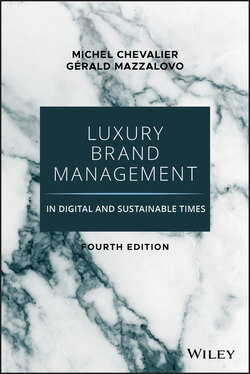Читать книгу Luxury Brand Management in Digital and Sustainable Times - Michel Chevalier - Страница 26
True Luxury, Intermediate Luxury
ОглавлениеHistorical and current definitions of luxury have been classified according to their receptive and productive dimensions; this has also been applied to the most common representations of consumers on luxury. Finally, some analytical instruments have been introduced.
We have seen that mass brands have learned to manage their operations by adopting the rules of traditional luxury: they seek to be present on the four vertices of the semiotic square of consumption values.
Therefore, what may differentiate a true luxury brand, in the sense that was intended 50 years ago, from a new entrant with a proper strategic understanding of the luxury industry and the talent to run an intermediate luxury positioning? One could mention longevity (the tradition, the legacy), but these criteria do not appear to have been taken into account, at least consciously, by the consumers interviewed for the study of the three scales. Are there other differentiating factors? How to distinguish, for example, Hermès from Bottega Veneta or Fendi?
We can invoke what Jean-Marie Floch calls “the refusal of an overall economic hegemony,”19 a brand attitude focusing on other values than the pure logic of profit. In other words, where intermediate luxury is seeking affordability, true luxury is going to position itself not as unaffordable but as foreign to the issue: the left side of the consumption square seems deserted. The stakes are elsewhere.
Very high luxury brands cultivate this type of signal to their consumers when they guarantee their products for life (as Bally was still doing in 2000 for the men's shoe model Scribe that it was repairing when sent back to headquarters), or even when they try to suggest that there is no preferential treatment—that all their customers receive the same (exceptional) attention to service, regardless of their volume of purchases. Some very selective brands can even promote sales models based on cooptation, where purchasing power seem irrelevant, in appearance, at least. This is a way of saying “our demand for quality puts us above mercantile considerations.” This confirms the differentiating role of the critical/economy vertex of the consumption square for true luxury brands (Figure 1.5).
In strict business logic, it is an irrational behavior and in fact it will naturally find its limits. But it is interesting to see that the brand claims it as a posture, that it makes it one of the keys of its identity. This is a major point of differentiation between true luxury and intermediate luxury: the latter cannot afford indifference, or even a hint of indifference, to economic imperatives. One can see also, in this somehow unnatural posture of a true luxury brand, a deviation that brings us back to the etymological sources of the word luxury. Luxury is an excess, a gap, a discontinuity, an eccentricity. It involves a shift from a norm, from a position retained as normal.
